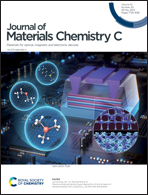Engineering dual charge transfer material modified ZnxCd1−xS towards highly effective photocatalytic pure water splitting†
Abstract
Facilitating the efficient separation of charge carriers is vitally crucial to achieving highly effective photocatalytic intermediate water splitting without any sacrificial reagents in pure water. Herein, the directional modulation separation of charge carrier strategy is proposed for Zn0.5Cd0.5S based on MOF-derived Co@NC and Co–Pi serving as dual charge transfer materials. The Co@NC acts as the electron transporting material to capture electrons and Co–Pi serves as the hole transporting material to extract holes, achieving the efficient separation of charge carriers and dramatically enhancing the photocatalytic performance. Moreover, the improved specific surface area can also provide more abundant active sites. The optimized Co@NC/Zn0.5Cd0.5S/Co–Pi sample achieved yields of H2 and H2O2 of up to 613.8 and 592.7 μmol h−1 g−1 in pure water, which are 13.2 and 14.4 times higher than that of pristine Zn0.5Cd0.5S, accompanied by a notable apparent quantum efficiency of 2.73% at 420 nm and the longest photocatalytic stability for 90 h. This work illustrates the importance of charge carrier separation to the photocatalytic performance and paves the way for designing highly efficient photocatalytic systems without sacrificial reagents.



 Please wait while we load your content...
Please wait while we load your content...